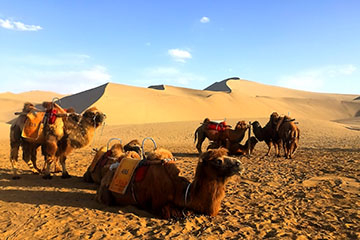Name in Chinese: 西安 xī ān [ʃi:’æ]
Location: Central Shaanxi, China, GMT+8
Population: 10.2 million as a prefecture, about 6.4 million living in the city proper
Telephone Code: +8629
Reputations: One of the World’s Historic Cities, the Eastern Terminus of the Silk Road
Xi’an is the capital city of Shaanxi Province. It is famed for its splendid history. The city used to be the capital of ancient China in thirteen dynasties, such as the Western Zhou Dynasty(1046B.C.-771B.C.), the Qin Dynasty(221B.C.-207B.C.), the Western Han Dynasty(202B.C.-8A.D.) and the Tang Dynasty(618-907). Xi’an was called Fenghao and Chang’an in ancient times. The archaeological site of Fenghao can be traced back to the 11th century B.C.. King Wen of the Western Zhou moved his capital to Xi’an and named it as Fenghao. In the Qin Dynasty, people were forced to build the Great Wall and Emperor Qin-Shihuang’s tomb. The Terracotta Warriors are a component of the tomb. The city was renamed as Chang’an by Liu Bang, the founding emperor of the Western Han. Chang’an means long-term political and social stability. In the following centuries, Xi’an served as the eastern terminus of the ancient silk road and exerted a strong influence on the world outside of the Great Wall. Merchants from Middle East and Europe traveled to Xi’an along the silk road for trading. The trade accelerated the cultural exchanges between China and western countries. Therefore, Xi’an is regarded as one of the world’s historic city. There are many popular sights in the city, such as the Terracotta Warriors, the Ancient City Wall, the Giant Wild Goose Pagoda, the Drum Tower and the Bell Tower. “If you have not been to Xi’an, you would never have been to China”, as the saying goes.
Attraction
The Terracotta Warriors
The site of the Terracotta Warriors is located 40 kilometers(25 miles) to the east of downtown Xi’an. There are over 8,000 life-size statues in three vaults. The warriors, horses and chariots are lined up and divided into cavalry and infantry units. All the statues were made and buried over 2,000 years ago. In March, 1974, some peasant farmers discovered several statues of warriors, when they were digging a well nearby the site. They reported the discovery to the government. Then, some archaeologists came and unearthed the vaults. The statues served as the funerary items for Emperor Qin-Shihuang, the first emperor in Chinese history. As one of the top three attractions in Mainland China, the assemblage of Terracotta Warriors and Horses has been billed as the Eighth Wonder of the World and added to the list of world cultural heritage sites by UNESCO in 1987.
The Ancient City Wall
In Xi’an, the Ancient City Wall is one of the main magnets for visitors. It is one of the few well-preserved defensive constructions which have survived in the world. The wall was initially built in the Tang Dynasty(618-907) and reconstructed in the Ming Dynasty(1368-1644). It is 12 meters(39 feet) high and 13.74 kilometers(8.5 miles) long.
The Giant Wild Goose Pagoda
The Giant Wild Goose Pagoda is situated at Cien Monastery. It was built by Master Xuanzang in the year of 652. The master traveled to India and brought Buddha’s holy books and statues back to China. The pagoda used to be the place where all of the statues and books were preserved. It is a seven-storied pagoda, is 64.5 meters(211.6 feet) in height.
Shaanxi History Museum
Shaanxi History Museum is situated in the south of the city proper. It covers an area of 6.5 hectares(16 acres) and houses over 1.71 million historical curiosities. As the first modernized museum in Mainland China, Shaanxi History Museum has become one of the must-see attractions in Xi’an.
The Great Mosque at Huajue Alley
The Great Mosque of Xi’an is quite famous in China. It was originally built in 742, during the reign of Emperor Tang-Xuanzong. The present buildings in the mosque can be traced back to the year of 1466. The mosque stands out in the Muslim Quarter where the visitors can leisurely stroll down the bustling street and try some local snacks.
The Drum Tower and the Bell Tower
Both the Drum Tower and the Bell Tower are landmarks of Xi’an. The two towers were constructed during the reign of Emperor Zhu Yuanzhang, the founding emperor of the Ming Dynasty. The former was built in the year of 1380, and the latter can be dated back to the year of 1384.
Climate
Xi’an has a semi-humid temperate climate. The monsoon lasts from July to September. The city was often struck by dust storms between February and May. Owing to the efforts made by Chinese Government to protect the environment, the dust storms have decreased in frequency over recent years. The temperature in Xi’an ranges from 1℃(33.8°F) to 10℃(50°F) in spring, 17℃(62.6°F) to 28℃(82.4°F) in summer, 22℃(71.6°F) to 32℃(89.6°F) in autumn, and 5℃(41°F) to 14℃(57.2°F) in winter. The best time to visit Xi’an is between April and October.
Food
Chinese Hamburger 肉夹馍 Ròu Jiā Mó [‘rəʊdʒa:mɔ:]
Chinese hamburger is the most famous local speciality of Xi’an. It is called Roujiamo by locals. Different from the hamburger eaten by westerners, Chinese hamburger is made from pork. The chopped meat and the bread roll are fried separately. The pork should be boiled with some seasonings after being fried so that the meat would be more tender and tasty.
How to Get to Xi’an
Xi’an is the most important aviation hub in Northwestern China. By the end of 2019, more than 100 domestic air routes and 70 internationals have been operating in Xi’an. The network covers Europe, North America, and Oceania with linked destinations around the world, such as Paris, Prague, Madrid, Melbourne, Los Angeles, San Francisco, etc. Travelers can fly to Xi’an from Beijing, Shanghai, Guangzhou, Chengdu and some other cities within Mainland China. They can also travel to Xi’an by bullet train from Beijing, Chengdu or Chongqing.
Author: Tina Luo
Update:

